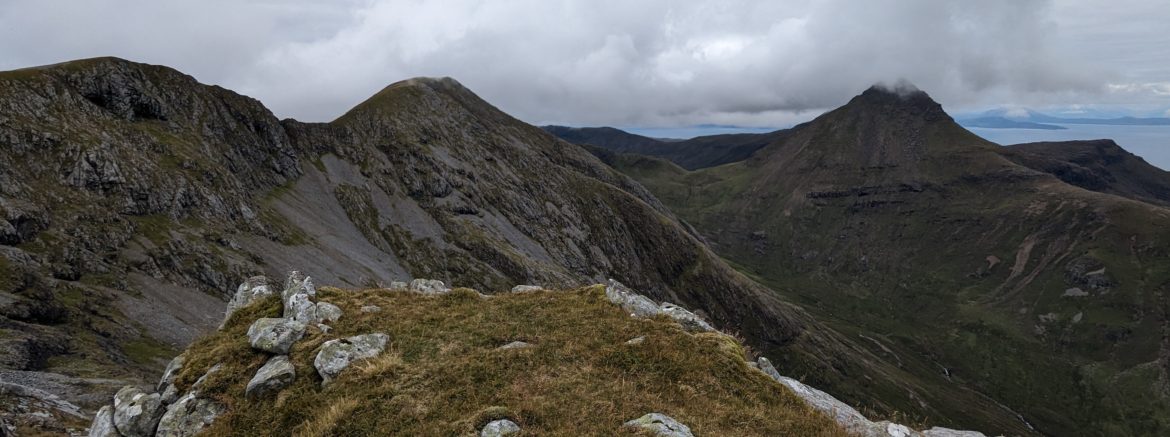The Isle of Rum is a special place. Located in the Inner Hebrides, it is an island where sea and mountains combine to give views that will live long in the memory. Walking here feels like a privilege and there are varied options available, although The Rum Cuillin from Dibidil Bothy must surely be one of the best. If you’re looking to complete a walk that offers everything from a coastal path to ridge lines connecting dramatic mountains, then this one should certainly be on your bucket list.

Why Start From Dibidil Bothy?
You may well have seen many articles that speak about starting and finishing the walk in Kinloch. This is where the few residents on Rum all live and it feels like a metropolis when compared to the rest of the island. Don’t worry though. It’s not a loud or rowdy place, as it has less than a hundred residents.
If you’re somebody who feels comforted by having others around, then you may still wish to consider this route. The Rum Bunkhouse makes for a comfortable stay and it also offers camping right beside the bay. Details about the walk from Kinloch can be found here.

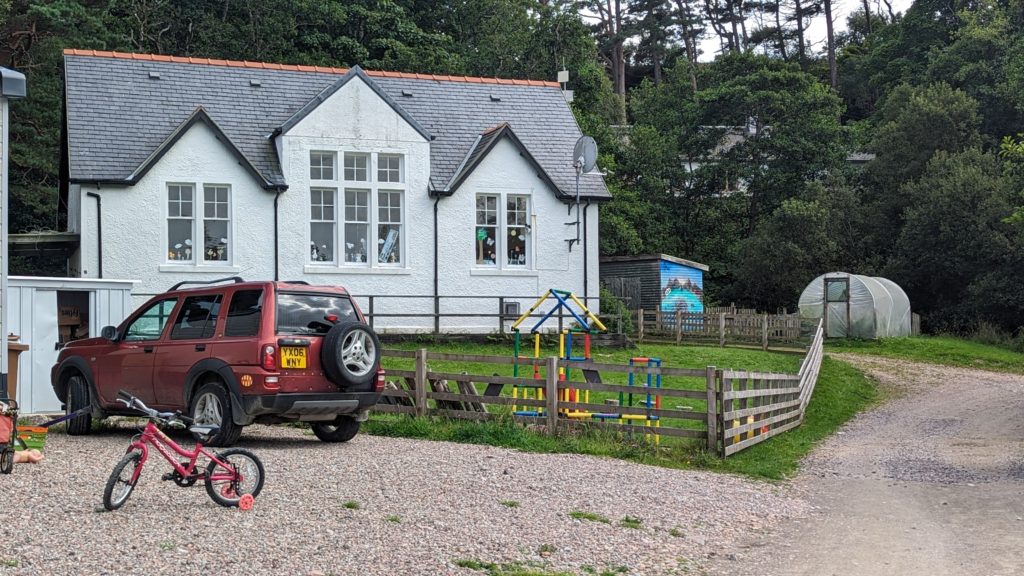
Solitude is what I was after though and Dibidil Bothy more than satisfied this desire. It also happens to be afforded with one heck of a view and location. The bothy interior being comfortable and well kept just adds to its appeal. I certainly found it a great place to stay. Please click here for more information about the bothy.
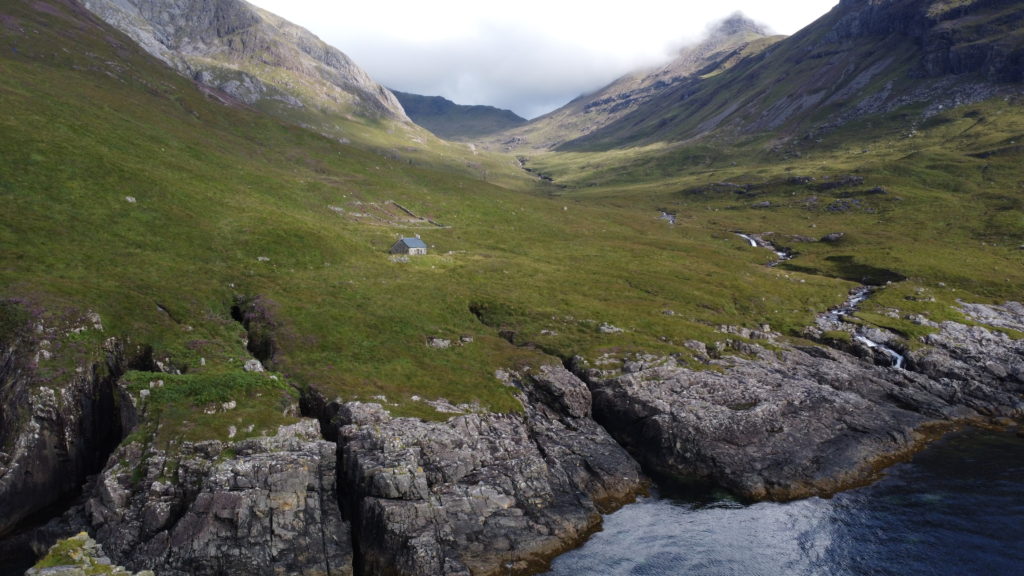
The real benefit of staying at Dibidil is that you have extremely easy access to the biggest mountains right from the door. I must confess that I felt sorry for a couple I met at the bothy, who had just hiked the Cuillin but then had to make the 2.5 hour trip back to Kinloch. While they trudged off to ford Dibidil River, I sat and watched several boats come and go just off the coast. A much better way to end the day I think.
The Route
I must state here that due to bit of a scare I had on the walk ( self inflicted not the route being dangerous ), I ended the ridge walk at the Bealach an Oir. From here it was an easy walk back along Glen Dibidil to the bothy. Certainly something to consider if you find you are pressed for time or just want to cut things short for another reason.
For me, it was annoying not to complete the entire circuit. Despite this, I don’t feel too hard done by. The hike was still physically challenging and the spectacular views that make this route so memorable were still enjoyed.
The final part of the route I’ve mapped out after the Bealach an Oir is based on reading I have enjoyed about other people’s trips. I also carefully studied the contour lines on the OS map. It is no steeper than the first climb behind the bothy, which although tough was manageable.
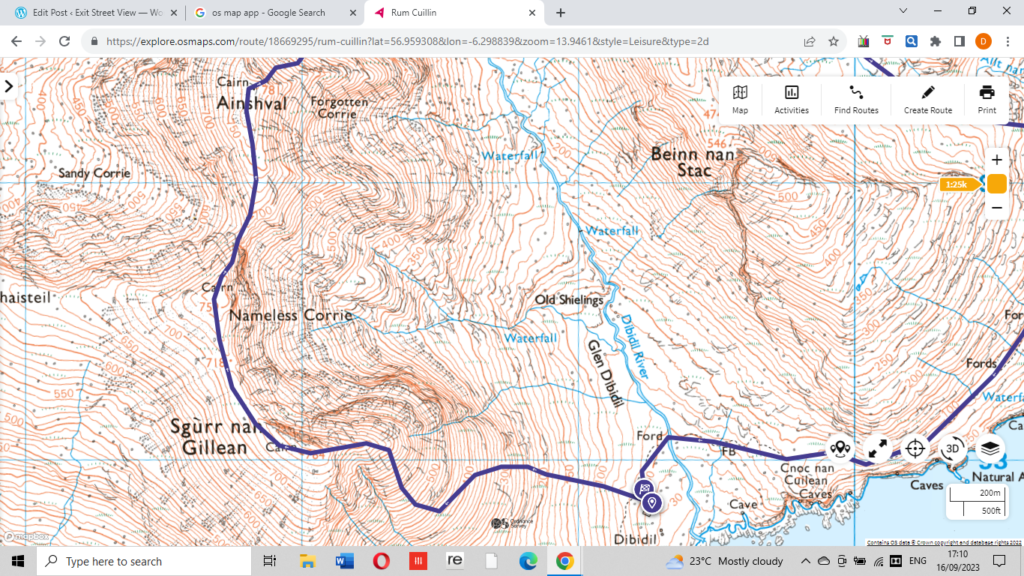

The First Climb
Your battle against gravity begins almost from the off, as you head skywards. The summit of Sgurr nan Gillean is the first summit of the day and it takes longer to reach than it looks like it should. Climbing from thirty metres above the sea to just over seven hundred and sixty will certainly get the burn going in the legs.
I found there to be a total absence of paths on the ascent too. It was therefore a case of picking the best line I could see and retracing my steps a couple of times if it proved to be harder than I initially thought. This is remote territory and there is every chance you may not see another person for hours if not days. It isn’t worth taking risks, as I found out near this first summit. I had underestimated one section, lost my footing and cut my ankle. Thankfully it was only a minor inconvenience, but it did make me very aware of the need to take things carefully.

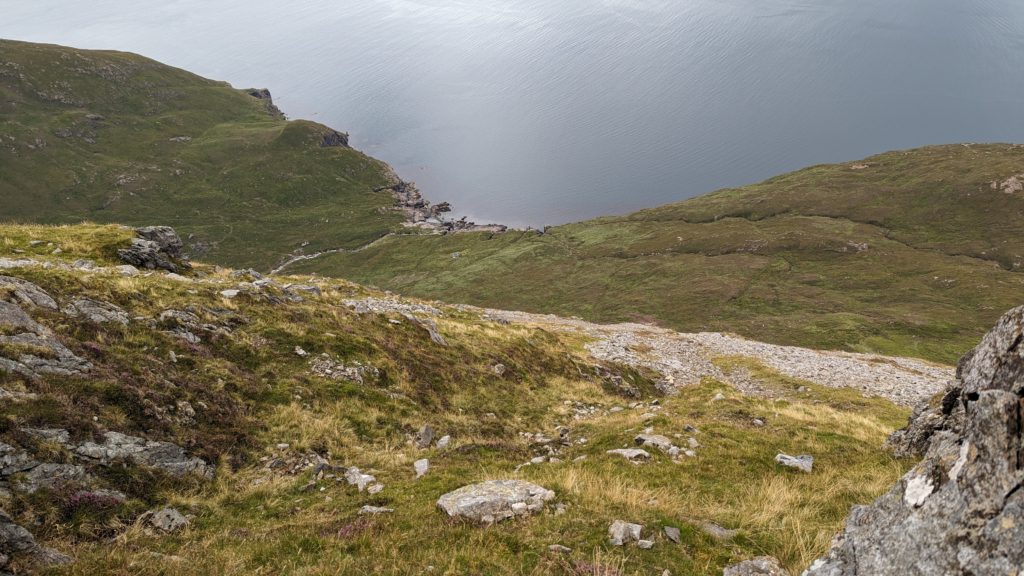
The long grass and heather helped provide plenty of grid for much of the climb. There were a couple of scree sections that helped balance this out, although they were never too loose and dangerous.
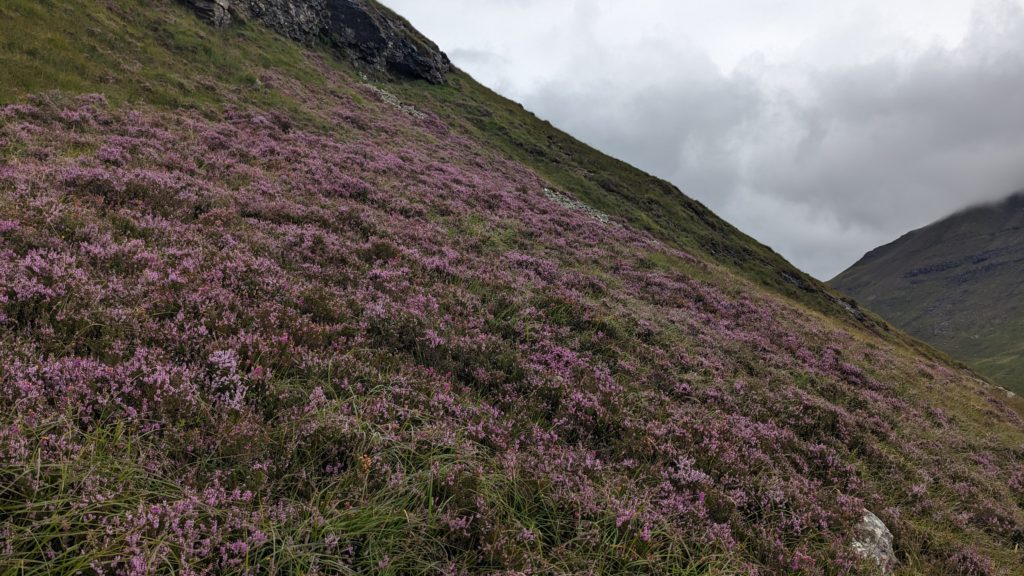

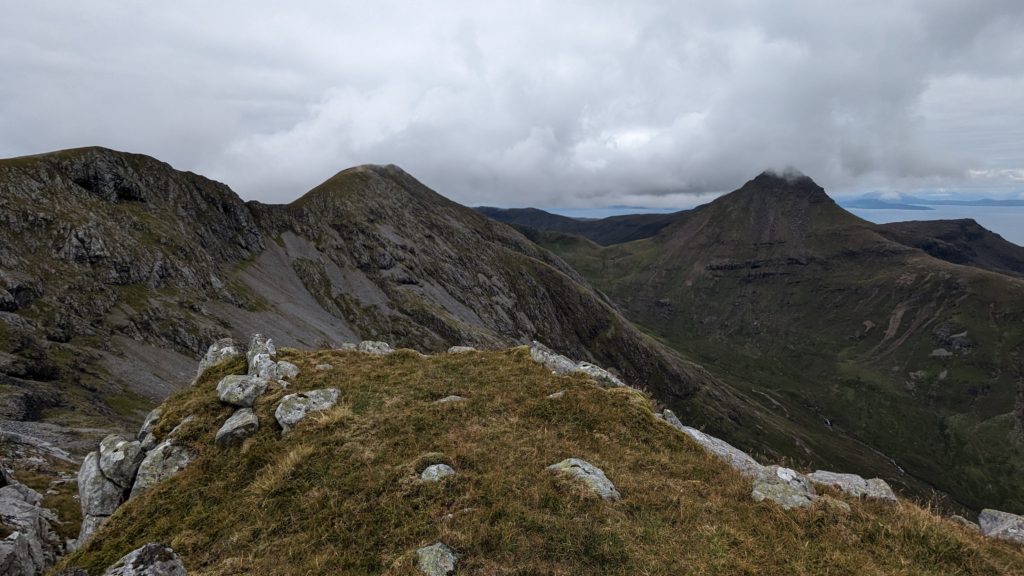
Hard Work Done For A Bit
After placing a stone on the summit cairn, it is uplifting to see that the hard work is done. At least for a bit anyway. A fairly clear path can be followed, as it sticks fairly close to the steep drop off into the glen. It is perfectly safe though and not at all technical at this point. Time to just relax and just take in the incredible views in all directions.
Looking to your left, the mountain drops away gradually until it reaches the sea. Various islands such as Coll and even the Outer Hebrides can be seen off in the distance, especially on a clearer day. I was even lucky enough to spot a herd of deer just below me. Unfortunately, I had the same effect on them that I do sheep in Wales- they took one look at me and ran away. It was great to see while it lasted though!
The view in front of you and to your right offers Scottish mountain scenery at its finest. I never though the view I got from the top of Slioch in Wester Ross would be topped, but this one was every bit as impressive.
Being a geographer at heart, I never tire of marveling at how landscapes have been shaped by water and time. The Isle of Rum was formed around 60 million years ago by an erupting volcano. Since then, water in both liquid and solid form during the last ice age has helped carve the many dramatic glens now found on the island. Glen Dibidil must be one of the most impressive. Scree and other larger rocks are scattered all over the mountain slopes- their final resting place decided by the retreating glacier from thousands of years ago. Amazing really!
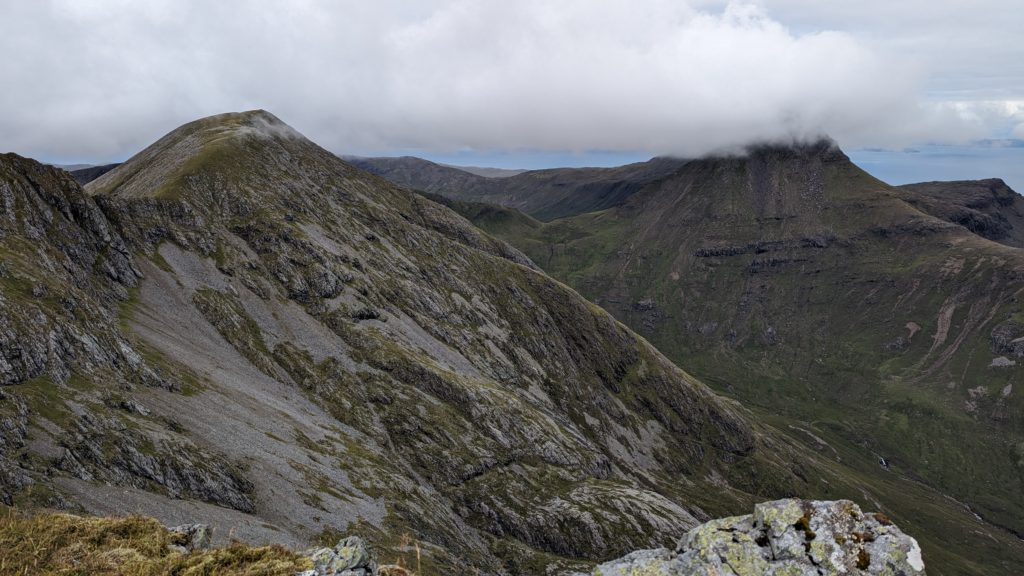
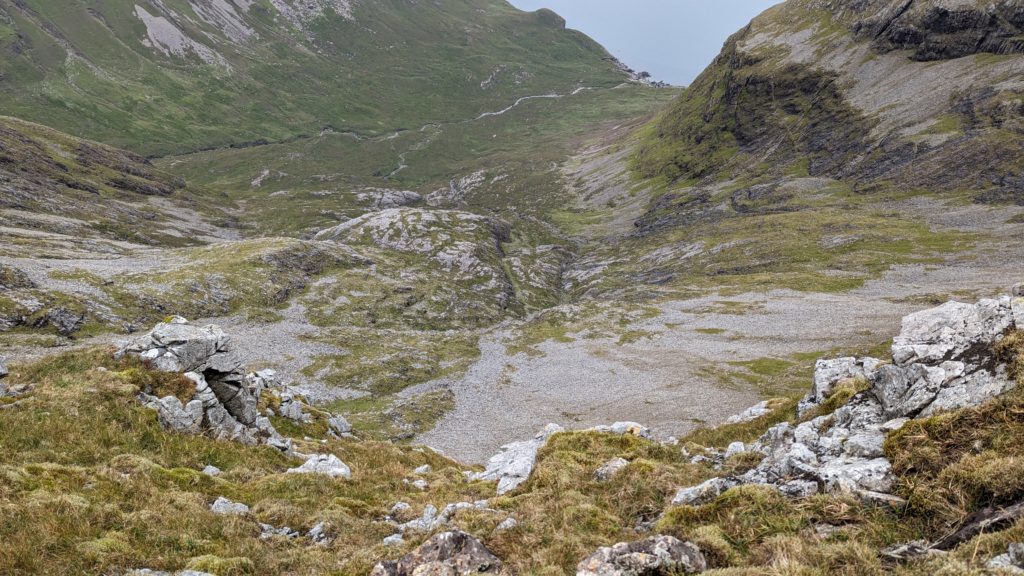

The Ridge Narrows
As you pass the oddly named ‘ Nameless Corrie’ on the map, so things become a little more technical. The ridge narrows and there is now a more considerable drop either side of you. It never feels dangerous though and I found that the rock offered excellent grip throughout. It was dry when I completed it however. If you’re up there on a wet or even icy day, then conditions underfoot might be rather more challenging.
There is a fairly clear path once again, which offers reassurance in knowing that the terrain has been tried and tested beforehand. I took my time on this section and just enjoyed the incredible views either side of me again. I’m normally terrified of heights, but fears thankfully seemed to evaporate at this point.
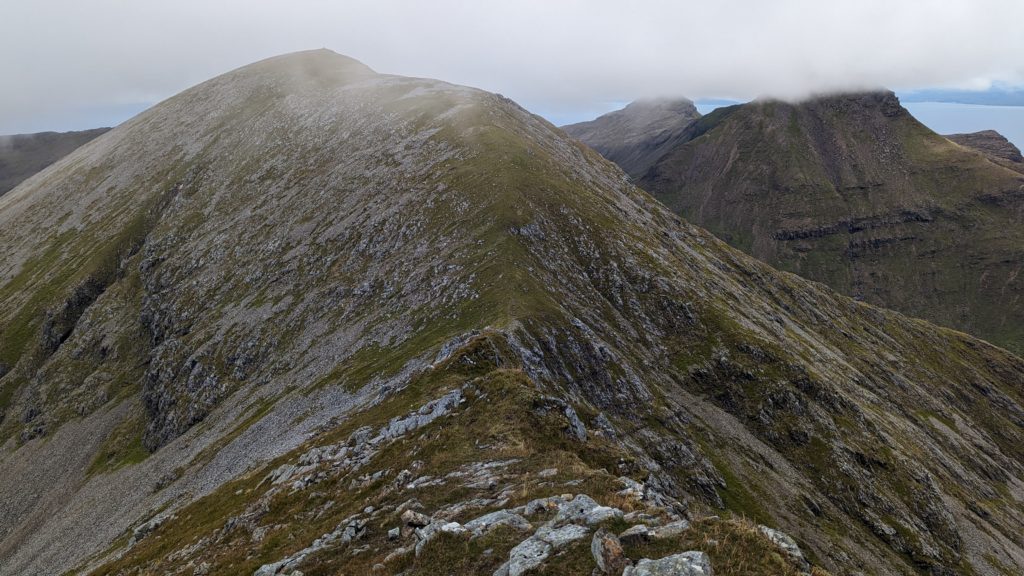
The Second Summit
After the excitement of the first ridge walk, the second summit of Ainshval comes into view. At 781 metres, it is the second highest mountain on the route, but it is more a slog to the summit than a tough scramble. It also offers a fairly expansive summit, which would make a wonderful spot for a wild camp.
I sat and chatted to two women from Glasgow, who were hiking the cuillin from the other direction. I’d remembered spotting them on the ferry the day before, so it was obvious they had come to Rum for the same reason as me. We all had to layer up, as it’s surprising how rapidly you can cool down at altitude, especially when sweaty and with a wind blowing.
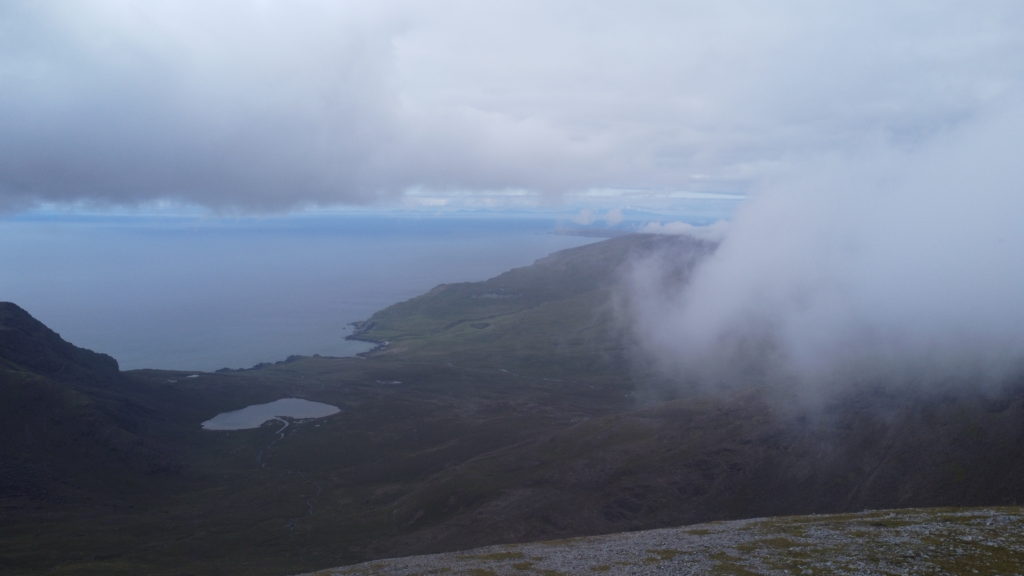
A Tricky Descent
The ground drops away quite steeply on the northern slopes of Ainshval and this will be the most challenging downhill section so far. A clear path isn’t very obvious, but thankfully the ladies at the summit had pointed me in the right direction. I did eventually pick up a faint path in the scree, but not before sliding on my bottom and taking things very easy beforehand.
I was certainly very thankful to be carrying my walking pole. These days I never hike without it. On this occasion it helped steady me on the loose ground and took the strain off my knees on the steeper bits. At just over £13.00, I consider my Vango Pico pole a brilliant piece of kit. It also happens to be one of the cheapest poles you can buy. Why people spend in excess of £50.00 for one made of carbon fibre I have no idea! If you are thinking about buying one, then please click here.
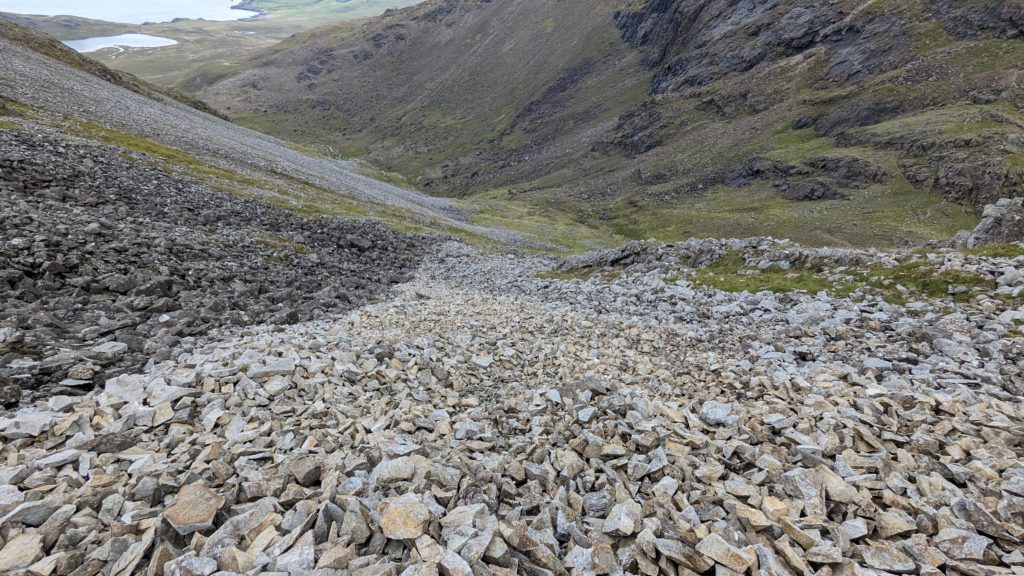
Scaling Trollabhal
After reaching the bottom of the scree, you reach the Beallach an Fhuarain. Maybe it’s just me, but I sometimes find it annoying to lose all the height you’ve just gained just to have to do it again. I forgave the mountain though. It is beautifully rugged and a lone fawn calling for its mum just added to the already wild feel.
It looks very steep and tough to climb, but in reality is never too tricky. Just stick to the well worn tracks and it is fine. Some minor scrambling is required, but it is nowhere near as challenging as over on Skye. Even with this being so, I’m not sure I’d want to be completing this part carrying a full pack of camping gear. I read in the bothy book about people completing the entire cuillin with their larger pack before ending at the bothy. I appreciated only carrying my day pack when slogging uphill and fighting gravity on the downhill sections. An extra few kilograms of weight on my back would only have made things harder and more dangerous. This is why I once again highly recommend completing the Rum Cuillin from Dibidil.
The Rest of The Route
It was at this point that I dropped down onto the Beallach an Oir before dropping down into Glen Dibidil and returning to the bothy. That alone is still a stunning walk. It is wonderful walking past springs marking the birth of new stream. I consider it almost a crime not to stop and take a well deserved drink. It was certainly some of the purest water I’ve ever sampled. The filter or purification tablets weren’t even touched and I’m still here to rave about it.
As you head down towards the sea, so The Dibidil River increases in size. Tributaries feed into it, many quite dramatically through a series of waterfalls. All the while you get to marvel at the mountains you’ve just scaled, which now loom high above you.
I’m sure you may well want to complete the rest of the cuillin though. For details about this, I’ve included several links below, which will hopefully be of use.

Options From Askival
The summit of Askival is the highest point of the entire route at 812 metres. Most walkers would then head on towards Hallival mountain before descending towards Kinloch. If staying at Dibidil Bothy, you will obviously need to take a different route. I studied this when outside the bothy and a good option looks to be similar to what is outlined in this excellent article here. Well worth the read for sure!
Eventually you will make it down to the coastal path. It is often very boggy, but the views more than make up for it. Wherever you arrive on it, you’ll need to turn right and head in that direction. Just be aware that rivers on rum can rapidly turn into torrents after heavy rain and the fords you’ll need to cross can become impassable. Once again, this is where I found a walking pole helpful in steadying myself as well as using these beach shoes for protection and grip when in the water. Well worth carrying in my opinion, unless you don’t mind wet boots.
To Wrap Things Up…
I hope I’ve helped show you why the Rum Cuillin from Dibidil Bothy should be in your bucket list. It may not contain any Munros, but the mountains are still rugged, dramatic and testing. On top of this, you get that amazing mix of land, sea and sky. The fact that the island takes an effort to reach makes it feel all the more amazing when you’re there too. There will be a fraction of the numbers of people along the way. Even during a settled spell in August, I only saw four people on the entire route. I’m not sure you’d have the same experience over on Skye.
